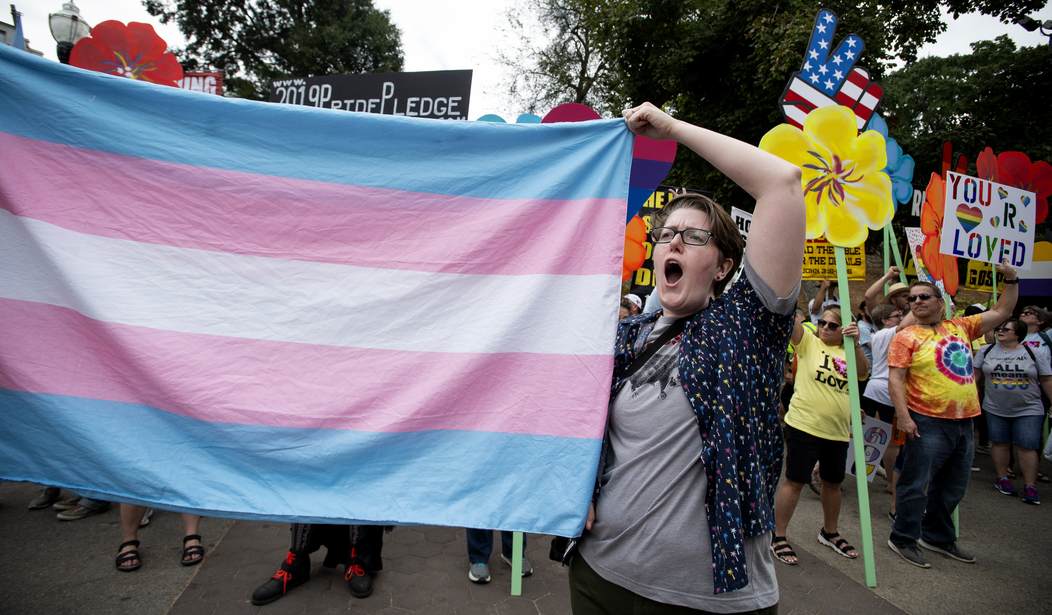The latest edition of Insanity Wrap — my weekly labor of love — included one of those cringeworthy TikTok videos of some poor, young soul with no clue about who they are, or even about basic biology.
In describing his?/her?/their? “gender,” a couple of brand-new terms he?/she?/they? used grabbed my attention. But getting into the details just isn’t inside the scope of a silly column like Insanity Wrap.
Still, I couldn’t get “genderfae” and “genderfloret” out of my brain, not even after a lovely evening spent with my wife, a bottle of wine, and a couple of cocktails.
So today I did some digging and was genuinely saddened by what I found.
Dating all the way back to 2014, genderfae “is a form of genderfluidity that never encompasses male or masculine genders,” according to the LGBTA Wiki. It even has its own flag as you can see at the link. That the colors are so washed out seems to me like a tell.
Genderfaes “can be fluid between any range of feminine genders, unaligned or neutral genders (such as aporagender), or genderlessness.”
Confusing things a bit further, Wiki readers are advised that genderfae “is not to be confused with faegender, which is a gender that changes with the seasons.” Can you imagine the horror and offense one might cause were one to confuse faegender with genderfae at a social gathering?
I am also informed that there exists a movement to “solidify into only using genderdoe or genderthil due to fae being revered in certain cultures.”
First, I’d like to know how a “movement” forms among a tiny subset of a tiny subset of a small population. But let’s stick a pin in that point because we have to get back to it momentarily.
Also for our VIPs: Cocktails with VodkaPundit: The Spanish Gin and Tonic
Second, “fae being revered” refers to fairy-worshipping pagans, another one of those tiny subsets of a tiny subset.
Genderfloret — “Not to be confused with Genderflorent” — is even more confusing to my eyes.
Again, from the LGBTA Wiki:
Genderfloret is a form of genderfluidity in which someone is only fluid between genders that are not male and/or masculine, or fully female. A genderfloret person can experience genders that are completely unaligned such as neutrois, maverique, agender, etc. They can also experience genders that are partly connected to femininity such as demigirl, juxera, librafeminine, etc. They never experience masculine genders. They are also never completely a woman.
Genderfloret, we’re told, comes from genderfrithet, a term coined in 2020, to describe people (plural? really?) who “would never experience genders like binary woman, neutrois, maverique, agender, etc.”
You would also not want to confuse genderfloret with demifloret, in which gender “is partially static and partially fluid.”
It moves except when it doesn’t, or perhaps the other way around.
If you were to conclude at this point that they were putting you on, who could blame you?
ASIDE: My spellcheck almost fainted this morning at the number of new words I’ve added. Not that I ever expect to use any of them again, but because there were so many red underscores in my text that I had trouble reading what I’d written.
I’m not writing this column in order to point and laugh, or acting like the carnival sideshow barker promising to show you The Incredible Snake Man for just 25 cents.
Also for our VIPs: Here’s the Real Reason Ben Stein Was Suspended From YouTube
Instead, I was reminded of my high school sweetheart who, a year or two after we split up, told me she was gay. Being a practical woman, she switched back to men after a few years. “There are just a lot more options,” she told me.
It’s a sad truth that being gay limits one’s options, as Rachel put it, to a small subset of the population. Gay or straight, pairing off and finding love is almost as essential to our nature as breathing or eating.
And I don’t just mean when it comes to sex.
“I’m a man and you’re a woman and isn’t that lovely?” (or the other way around) is an attitude that keeps open doors to an almost unlimited number of broadening experiences.
During my heady dating days, I was free to meet and date people from almost any background, ethnicity, political leaning, etc., for no reason more complicated than I hadn’t sliced my gender (ouch!) into some razor-thin, and mostly imaginary, portion.
But how is a person supposed to become intimate — I mean emotionally intimate — when their entire identity is wrapped up in imaginary buzzwords and takes genuine offense at anyone who doesn’t somehow “get” them?
It’s clear from a morning’s worth of reading that they don’t even get themselves, at an age when their personal identities ought to be almost fully formed.
Genuine transgenderism is a difficult, even tragic condition to suffer if suicide rates are anything to go by.
The normalization and, worse, the popularization of pretend transgenderism is encouraging untold numbers of young adults to embrace a life of confusion.
And worse, of loneliness.










